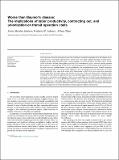Worse than Baumol's disease: The implications of labor productivity, contracting out, and unionization on transit operation costs
Author(s)
Morales Sarriera, Javier; Salvucci, Frederick P; Zhao, Jinhua
DownloadAccepted version (165.5Kb)
Terms of use
Metadata
Show full item recordAbstract
Unit costs measured as bus operating costs per vehicle mile have increased considerably above the inflation rate in recent decades in most transit agencies in the United States. This paper examines the impact of (lack of) productivity growth, union bargaining power, and contracting out on cost escalation. We draw from a 17-year (1997–2014) and a 415-bus transit agency panel with 5780 observations by type of operation (directly operated by the agency or contracted out). We have three main findings: first, the unit cost increase in the transit sector is far worse than what economic theory predicts for industries with low productivity growth. Second, contracting out tends to reduce unit costs, and the results suggest that the costs savings from private operations can be only partly explained by lower wages in the private sector. Interestingly, we find that the cost savings from contracting out are larger when the transit agency also directly operates part of the total transit service. However, while overall unit costs are lower in contracted services, cost growth in large private bus operators is no different than cost growth in large public transit operators. Third, unique transit labor laws that lead to union bargaining power are a likely driver of the unit cost growth above inflation. Overall, these factors reflect inherent characteristics of the bus transit sector, such as the nature of low productivity growth and union legislative power related to the need for public subsidy. They drive increases in both transit fares and public subsidy at rates higher than inflation, and play an important role in the deterioration of transit agencies’ financial sustainability.
Date issued
2018-01Department
Massachusetts Institute of Technology. Center for Transportation & Logistics; Massachusetts Institute of Technology. Department of Urban Studies and PlanningJournal
Transport Policy
Publisher
Elsevier BV
Citation
Morales Sarriera, Javier, ; Frederick P. Salvucci, Jinhua Zhao. "Worse than Baumol's disease: The implications of labor productivity, contracting out, and unionization on transit operation costs." Transport Policy, vol. 61 (January 2018):pp. 10-16. © 2017 Elsevier Ltd.
Version: Author's final manuscript
ISSN
0967-070X